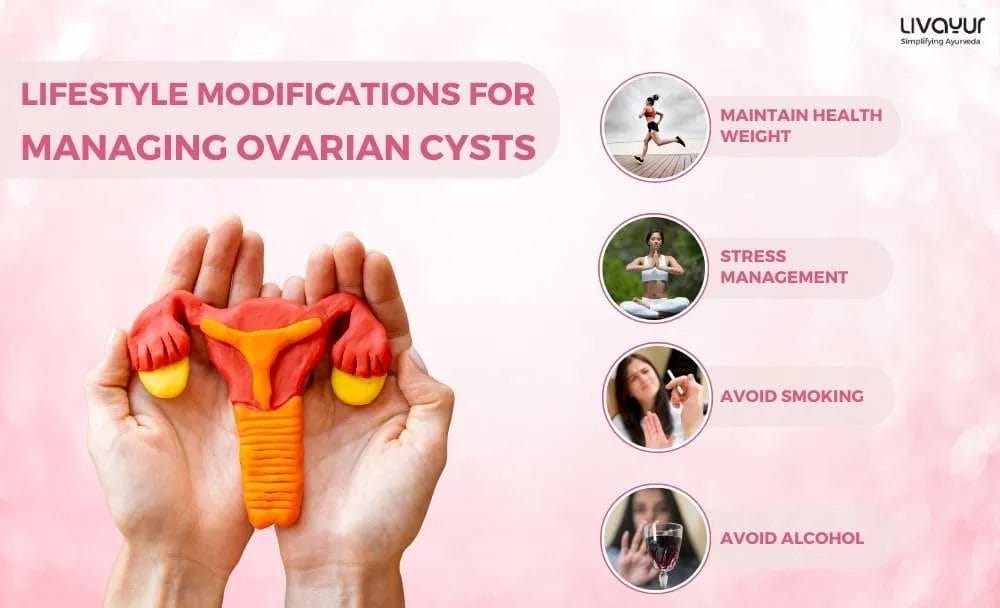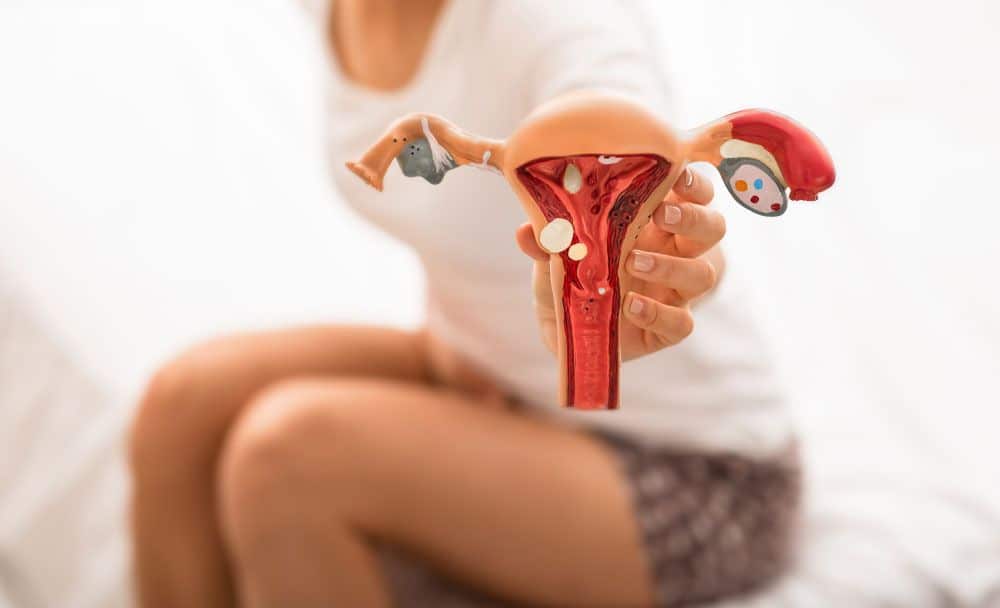Ovarian cysts are a common gynecological condition faced by women. These fluid-filled sacs can develop on or within the ovaries and vary in size, ranging from small and unnoticeable to large and potentially problematic. While most ovarian cysts are harmless and benign in nature, and resolve independently after a certain period of time, some can cause discomfort and complications, requiring medical intervention. Understanding what ovarian cysts are and the various ovarian cyst treatment options is crucial for women’s health and well-being. [1]
This article will inform you about the nature of ovarian cysts, their causes, symptoms, and the various ovarian cyst treatment options available. By understanding this condition comprehensively, women can make informed decisions about their health and seek timely medical assistance when necessary.
What is an ovarian cyst?
An ovarian cyst may be defined as a fluid-filled sac that crops up on or within the ovaries, which are part of a woman’s reproductive system. The ovarian cyst treatment primarily depends on its nature, as well as the accurate preoperative determination of whether a cyst is of benign or malignant nature. This is of crucial importance and operation is recommended in women with cysts larger than 5 cm or with elevated levels of CA-125. It is suggested by experts that any woman manifesting symptoms of ovarian cysts should be operated on irrespective of age, menopausal status, or ultrasound findings. [2]
What are the various types of Ovarian Cysts?
There are multiple categories of ovarian cysts, including functional cysts, dermoid cysts, endometriomas, and cystadenomas. Functional cysts, such as follicular and corpus luteum, are the most common types and often resolve independently. [1]
What are the various treatment options for ovarian cysts?
Observation and Monitoring:
Many small, asymptomatic ovarian cysts require no ovarian cyst treatment and may resolve independently. In these cases, healthcare providers may recommend regular monitoring through pelvic examinations and ultrasounds to ensure the cyst does not grow or cause any complications. [1]
Initial intervention:
Since most cysts resolve spontaneously without intervention, a serial transvaginal ultrasound is recommended initially. In case a cyst does not resolve after several menstrual cycles, probably it is not a functional cyst, and thus further workup or ovarian cyst treatment is indicated. [7]
Surgical Interventions:
Surgery may be required in certain situations to remove the cyst and is the only ovarian cyst treatment possible. The surgical procedure a woman opts for depends on factors such as the cyst’s size, type, and characteristics, as well as the woman’s age and desire for future fertility.
Laparoscopy:
Laparoscopic surgery is a minimally invasive surgical procedure that involves making small holes in one’s abdomen and inserting a thin, lighted instrument called a laparoscope. The surgeon then removes or drains the cyst through these incisions, minimizing scarring and promoting faster recovery. [1]
Laparotomy:
Laparotomy is a more extensive surgery that requires a larger abdominal incision. This ovarian cyst treatment is usually performed when the cyst is large, suspicious of malignancy, or if other complications are present. In some cases, the affected ovary may need to be partially or entirely removed. [1]
Simple ovarian cyst treatment:
These are quite common among women and a simple ovarian cyst treatment may either be medical or surgical. It is recommended that postmenopausal women with an ovarian cyst should have a CA125 performed, and in case a cyst is over 50 mm, it should be removed intact. A simple ovarian cyst treatment also suggests that other women should undergo rescanning every 3 months and, if an increase or change in nature is perceived, must undergo surgery. [6]
Hemorrhagic Ovarian cyst treatment:
These are the most common ovarian cysts in India and are usually large and painful. These cysts may require surgery for removal. However, Ayurveda recommends some effective non-invasive treatments for this type of ovarian cysts, which are called ‘Kaphaja Granthi’ or ‘Granthi Aartav dosha’. The tissues associated with these cysts are Rasa, Rakta dhatus and Artava Vaha Srotas. The best Ayurvedic hemorrhagic ovarian cyst treatment includes a preparatory therapy of Sanjeevani Vati and Triphala Churna for 15 days followed by a main therapy of Kalyanakaghrita upto 90 days and Kanchanargugulu up to 120 days after the initial treatment. [3]
Follicular ovarian cyst treatment:
Follicular ovarian cysts usually manifest with symptoms such as combined breast pathology and clinical symptoms associated with hyperestrogenocity. It has been seen that mastophemin and combined oral contraceptives for treating women with follicular ovarian cysts have led to greater efficacy. [4]
Ovarian dermoid cyst treatment:
This is most commonly found in adolescence and during pregnancy, and while the tumor is usually asymptomatic, some patients complain of abdominal pain. An Ovarian dermoid cyst treatment may require a procedure called oophorectomy which is a complete removal of the affected ovary or both ovaries. [5]
FAQs
- What are the major lifestyle changes that can help manage ovarian cysts?
Certain lifestyle modifications can help manage ovarian cysts and reduce the risk of their formation or recurrence. These may include maintaining a healthy weight, exercising regularly, managing stress levels, and avoiding tobacco and excessive alcohol consumption.
- How can ovarian cysts be diagnosed?
If a healthcare provider suspects an ovarian cyst, they may perform a combination of tests, including pelvic examinations, ultrasounds, blood tests (to check hormone levels), and laparoscopy (a minimally invasive procedure that allows direct visualization of the ovaries).
- What are the symptoms of ovarian cysts?
Most ovarian cysts do not cause noticeable symptoms and are discovered during routine pelvic examinations. However, larger cysts or those that lead to complications may present various symptoms, including pelvic pain or pressure, bloating, irregular menstrual cycles, pain during intercourse, and changes in urinary or bowel habits.
- Are there any ovarian cyst treatment antibiotics?
Hormonal contraceptives, such as birth control pills, can regulate hormone levels, reduce the formation of new cysts, and help shrink existing ones. Nonsteroidal anti-inflammatory drugs (NSAIDs) may also be prescribed to relieve pain and inflammation associated with ovarian cysts.
- What is the best detox for ovarian cysts?
Teas like herbal tea like chamomile tea are seen as great remedies for ovarian cysts. You can simply mix two teaspoons of dried chamomile and one tsp of honey in a cup of hot water. Leave it covered for five minutes and then drink two to three such cups of tea daily until you see positive changes.
Conclusion
Ovarian cysts are common among women, with most cases being benign and resolving without complications. However, for cysts that cause symptoms or pose a risk of complications, various treatment options exist, including right ovarian hemorrhagic cyst treatment, hemorrhagic ovarian cyst treatment, ovarian cyst treatment antibiotics, and simple ovarian cyst treatment, among others. From conservative approaches like monitoring and medication to surgical interventions, the treatment choice depends on factors such as the size, type, and characteristics of the cyst, as well as the woman’s overall health and reproductive goals.
Disclaimer:
This article is written from a health and wellness perspective and is not medical advice. Kindly seek the help of a certified medical practitioner before initiating any treatment.





















